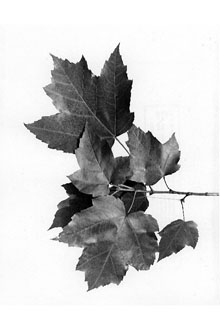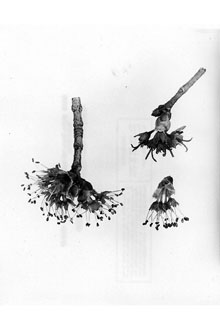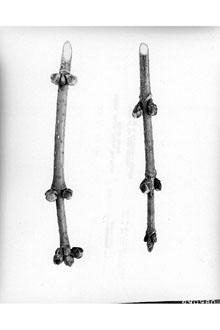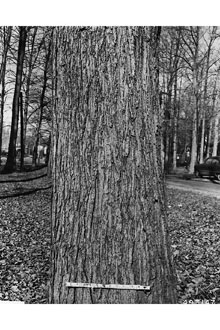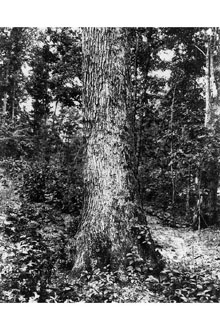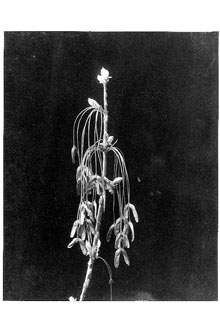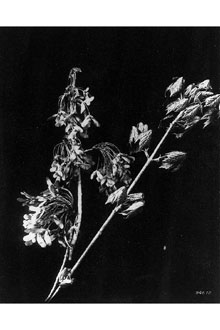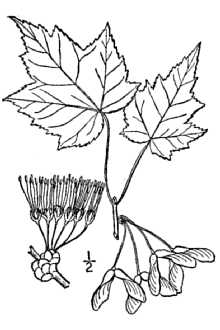Red Maple
Scientific Name: Acer rubrum L.
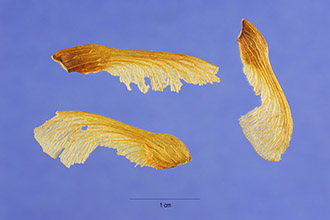
| General Information | |
|---|---|
| Usda Symbol | ACRU |
| Group | Dicot |
| Life Cycle | Perennial |
| Growth Habits | Tree |
| Native Locations | ACRU |
Plant Guide
Uses
Red maple has long been valued as an ornamental tree (shade, specimen, autumn accent, or wet site) because of its ease of establishment, rapid growth, brightly colored flowers and fruit, and fall leaf colors (ranging from clear yellow to orange to vivid red) displaying coloring during different seasons of the year. This tree is preferred over silver maple or boxelder when a fast growing maple is needed. Red maple can be planted onto many types of disturbed sites in rehabilitation projects. The white, fine-grained wood is used for furniture, flooring, cabinetry, paneling, veneer, musical instruments, tool handles, cutting boards, butcher blocks, wooden bowls, boxes and crates, and many other uses. Red maple is an excellent wood for fuel and is also used for saw timber and pulpwood. But because of susceptibility to defects and disease and poor form of individuals of sprout-clump origin, the timber is often low in quality. The sap of red maple is sometimes used for producing maple syrup. Although its sap has only about half the sugar content as sugar maple (A. saccharum), the syrup tastes good. Saponins in the sap may cause excessive frothing of the concentrate. Native Americans used red maple bark as an analgesic, wash for inflamed eyes and cataracts, and as a remedy for hives and muscular aches. Tea brewed from the inner bark has been used for treating coughs and diarrhea. Pioneers made cinnamon-brown and black dyes from a bark extract. Iron sulphate was added to the tannin from red maple bark to make ink. Because of the abundance and wide distribution red maple, its early-produced pollen may be important to the biology of bees and other pollen-dependent insects. Most references describe red maple as wind pollinated, but insect pollination may be important, as many insects, especially bees, visit the flowers. The seeds, buds and flowers are eaten by various wildlife species. Squirrels and chipmunks store the seeds. White-tailed deer, moose, elk browse red maple, and rabbits, which find the stump sprouts especially palatable, especially in fall and winter. Cavities in red maples in river floodplain communities are often well suited for cavity nesters such as the wood duck and others.
Status
Please consult the PLANTS Web site and your State Department of Natural Resources for this plant’s current status, such as, state noxious status and wetland indicator values, This species has been introduced in many areas of the U,S,, outside of its native range, Use soil moisture sensors to measure the soil moisture of Red Maple.,
Description
General: Maple Family (Aceraceae). A native tree growing to 20 m tall, usually with a narrow compact Plant Materials <http://plant-materials.nrcs.usda.gov/> Plant Fact Sheet/Guide Coordination Page <http://plant-materials.nrcs.usda.gov/intranet/pfs.html> National Plant Data Center <http://npdc.usda.gov>
Adaptation
Red maple is also one of the most successful and abundant species in the Eastern Deciduous Forest, arguably the most abundant, reproducing aggressively by seeds and sprouts after fire, logging, and abandonment of farmland. It is most abundant on bottomlands and is tolerant of waterlogged soils and flooding, but it is a “supergeneralist,” growing on the widest variety of sites and in the greatest range of conditions (sunny or shady, high or low nutrients, dry or moist) of any North American species, from 0-900 meters. Because red maple grows well in shade, is a key late-successional species, but it also is a successful early successional invader of disturbed sites. “It will probably continue to increase in dominance in the overstory during the next century, causing widespread replacement of the historically dominant trees of the forests of the eastern United States” (Abrams 1998, p. 355). Fire suppression has contributed greatly to the spread of red maple (the thin bark makes it highly susceptible to fire damage) but no single trait is responsible for its success. Flowering: (February-)March-April, before the vegetative buds, one of the first trees to flower in the spring; fruiting: April-June, before leaf development is complete.
Establishment
Red maple is a prolific seed producer and trees as young as four years may begin to bear seeds. Good seed crops are usually produced in alternate years. Seedbed requirements are minimal and up to 95% of viable seeds germinate in the first 10 days; some survive in the duff and germinate the following year. Because the mature seeds are dispersed in spring and can germinate immediately, seedlings can become established with a 3-4 month advantage over most associated woody species. A bank of persistent seedlings often accumulates beneath a forest canopy. Seedlings can survive 3-5 years of moderate shade, but establishment and early growth are best after disturbance. Male (staminate) trees may grow faster than female ones. Average longevity for red maple is about 80-100 years, but trees are known to reach 200 years of age. Vegetative reproduction under natural conditions is common from sprouts from the stump or root crown or root suckers after fire or mechanical damage. Buds located at the base of stems commonly sprout 2-6 weeks after the stem is cut.
Management
Red maple is easily transplanted and is one of the easiest trees to grow. It is abundantly available in commerce, in ball-and-burlap and in container, but where other fertile trees grow in the area, volunteers usually are common. Propagation of cultivars is by budding onto seedling understock or rooted stem cuttings – the species form (although rarely propagated) by rooted stem cuttings or by seeds. Softwood cuttings are propagated under mist, using 1000-3000 ppm IBA, in about four weeks. Despite its value and wide use (even to the point of over-planting in some areas), red maple has some drawbacks as a lawn and street tree. As a street tree, it often becomes too large, and it does not respond well to some urban stresses, particularly protracted drought because of the planting site or long spells of hot dry weather. One of the "soft maples," red maple branches are weak and somewhat brittle and are subject to storm damage. The bark is thin and easily damaged by mechanical impact (including lawn mowers, weed eaters, and even increment boring) as well as fire, allowing entry of various damaging fungi and insects – butt rot, trunk rot fungi, heart rot, and stem diseases are common in damaged trees, although pests and pathogens otherwise are relatively few. As in some other maples, feeder roots develop close to the surface and turf and other shallow-rooted plants must compete directly with the tree for water. Turf beneath the canopy often is stunted and mowing may be difficult because of the protruding roots. Growth in alkaline soils may lead to leaf chlorosis and a weakly growing tree, especially among the cultivars. Fertilization in spring can help overcome this. Graft incompatibilities have appeared between some cultivars of red maple and their rootstock, the trees often breaking off at the union between scion and rootstock, but propagation by softwood cutting has circumvented this problem. Cultivars, Improved and Selected Materials (and area of origin) Many cultivars of red maple have been developed. Selections have been made for color tints and brightness, timing of onset of coloration, crown shape and branching pattern, cold hardiness, leaf size, only male flowers (no seeds or seedlings), and leafhopper resistance.
References
Abrams, M. 1998. The red maple paradox. What explains the widespread expansion of red maple in eastern forests? Bioscience (May), 355-364. Anonymous 2000. Why is swamp thing (red maple) taking over the forests? Univ. of Connecticut Cooperative Extension Forestry. AUG00. <www.canr.uconn.edu/ces/forest/redmaple.htm> Koelling, M.R. & R.B. Heiligmann (eds.) 1996. North American maple syrup producers manual. Ohio State Univ. Extension Bull. 856. AUG00. <http://www.ag.ohio-state.edu/~ohioline/b856/index.html> Li, H.-L. 1960. The cultivated maples. Morris Arbor. Bull. 11:41-47. Tirmenstein, D.A. 1991. Acer rubrum. IN: W.C. Fischer (compiler). The fire effects information system [data base]. USDA, Forest Service, Intermountain Research Station, Intermountain Fire Sciences Laboratory, Missoula, Montana. Walters, R.S. & H.W. Yawney 1990. Acer rubrum L. Red maple. Pp. 60-69, IN: R.M. Burns and B.H. Honkala (tech. coords.). Silvics of North America. Volume 2. Hardwoods. USDA, Forest Service Agric. Handbook 654, Washington, D.C.
Fact Sheet
Alternative Names
swamp maple
Uses
Erosion control: Red maple is available in quantity for revegetation work and landscaping. It is a valuable riparian buffer plant due mostly to it’s tolerance of wetter soils. Wildlife: Red maple seeds provide food for squirrels and some birds. The species is not preferred by deer as a browse source, so in heavy deer pressure this species is over abundant in forest regeneration. Wood: The wood is not desirable for lumber or veneer.
Status
Please consult the PLANTS Web site and your State Department of Natural Resources for this plant’s current status (e.g. threatened or endangered species, state noxious status, and wetland indicator values).
Weediness
This plant may become weedy or invasive in some regions or habitats and may displace desirable vegetation if not properly managed. Please consult with your local NRCS Field Office, Cooperative Extension Service office, or state natural resource or agriculture department regarding its status and use. Weed information is also available from the PLANTS Web site at plants.usda.gov.
Description
Acer rubrum L., red maple, is a wide-ranging native tree that is very well adapted to most soil and site conditions. This species is one of the early harbingers of fall as it turns color well in advance of other eastern deciduous trees, especially when it is located in wet sites. The fiery colors of fall are typically a brilliant red. Conversely, it is also one of the earliest flowering trees in the spring. Red maple has the smallest winged seeds (samaras) of all native maples, about 5/8-3/4 inches long. Also, the samaras ripen in the spring- a trait shared only with silver maple which has much larger samaras. This maple is a medium sized tree with fairly rapid growth (2-5 ft/yr), but not as fast as the much larger growing silver maple. © William S. Justice Smithsonian Institution @USDA NRCS PLANTS
Adaptation and Distribution
Distribution
Distribution
Red maple is adapted to wet sites where it associates with black ash, cottonwood, and black gum, Some forested wetlands are referred to as maple swamps due to their stands of red maple, However, red maple is also well adapted to well drained but moist soils of upland sites where its companions are sugar maple, beech, black cherry and the birches, This capability makes this species a common tree in home landscapes where the fall colors can be displayed, The range of red maple extends from Florida to the Maritimes and west to Texas and Minnesota, Red maple is shade tolerant, For a current distribution map, please consult the Plant Profile page for this species on the PLANTS Website, , Use soil moisture sensors to measure the soil moisture of Red Maple.
Establishment
Red maple seed is easily germinated in nature or in nurseries. The seed can be direct planted with no pre-treatment. The seedlings have moderately fast growth and are usually outplanted as 1 year old or 2 year old bareroot stock.
Management
Red maple seedlings must be protected from fire and livestock, and are greatly aided where weed and grass competition is controlled. This is particularly true in any plantings where grass sod is the cover between trees. Weed control mulch or fabric, or herbicide treatments are recommended for the first three years or longer.
Plant Traits
Growth Requirements
| Temperature, Minimum (°F) | -47 |
|---|---|
| Adapted to Coarse Textured Soils | Yes |
| Adapted to Fine Textured Soils | Yes |
| Adapted to Medium Textured Soils | Yes |
| Anaerobic Tolerance | Medium |
| CaCO3 Tolerance | High |
| Cold Stratification Required | No |
| Drought Tolerance | Medium |
| Fertility Requirement | Medium |
| Fire Tolerance | Low |
| Frost Free Days, Minimum | 80 |
| Hedge Tolerance | Low |
| Moisture Use | High |
| pH, Maximum | 7.3 |
| pH, Minimum | 4.7 |
| Planting Density per Acre, Maxim | 1200 |
| Planting Density per Acre, Minim | 170 |
| Precipitation, Maximum | 80 |
| Precipitation, Minimum | 25 |
| Root Depth, Minimum (inches) | 30 |
| Salinity Tolerance | None |
| Shade Tolerance | Intermediate |
Morphology/Physiology
| Bloat | None |
|---|---|
| Toxicity | Slight |
| Resprout Ability | Yes |
| Shape and Orientation | Rounded |
| Active Growth Period | Spring and Summer |
| C:N Ratio | High |
| Coppice Potential | Yes |
| Fall Conspicuous | Yes |
| Fire Resistant | No |
| Flower Color | Red |
| Flower Conspicuous | Yes |
| Foliage Color | Green |
| Foliage Porosity Summer | Dense |
| Foliage Porosity Winter | Porous |
| Foliage Texture | Medium |
| Fruit/Seed Conspicuous | Yes |
| Nitrogen Fixation | None |
| Low Growing Grass | No |
| Lifespan | Short |
| Leaf Retention | No |
| Known Allelopath | No |
| Height, Mature (feet) | 68.0 |
| Height at 20 Years, Maximum (fee | 35 |
| Growth Rate | Rapid |
| Growth Form | Single Stem |
| Fruit/Seed Color | Red |
Reproduction
| Vegetative Spread Rate | None |
|---|---|
| Small Grain | No |
| Seedling Vigor | Medium |
| Seed Spread Rate | Moderate |
| Seed per Pound | 22720 |
| Fruit/Seed Persistence | No |
| Propagated by Tubers | No |
| Propagated by Sprigs | No |
| Propagated by Sod | No |
| Propagated by Seed | Yes |
| Propagated by Corm | No |
| Propagated by Cuttings | No |
| Bloom Period | Early Spring |
| Commercial Availability | Routinely Available |
| Fruit/Seed Abundance | High |
| Fruit/Seed Period Begin | Spring |
| Fruit/Seed Period End | Spring |
| Propagated by Bare Root | Yes |
| Propagated by Bulb | No |
| Propagated by Container | Yes |
Suitability/Use
| Veneer Product | Yes |
|---|---|
| Pulpwood Product | Yes |
| Protein Potential | Low |
| Post Product | No |
| Palatable Human | Yes |
| Palatable Graze Animal | Low |
| Palatable Browse Animal | Medium |
| Nursery Stock Product | Yes |
| Naval Store Product | No |
| Lumber Product | Yes |
| Fuelwood Product | Medium |
| Fodder Product | No |
| Christmas Tree Product | No |
| Berry/Nut/Seed Product | No |

